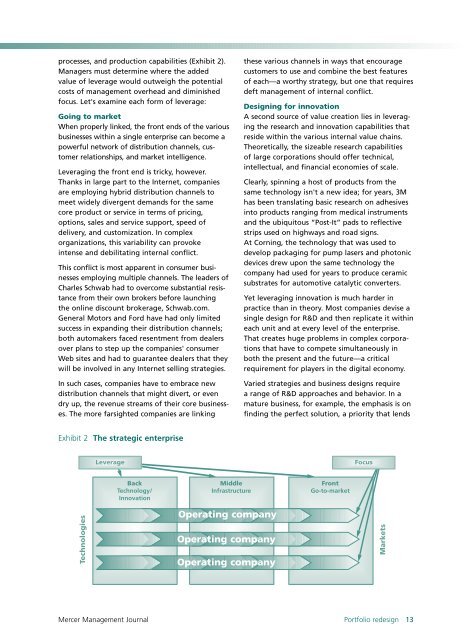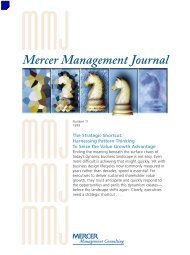Download the Report - Oliver Wyman
Download the Report - Oliver Wyman
Download the Report - Oliver Wyman
Create successful ePaper yourself
Turn your PDF publications into a flip-book with our unique Google optimized e-Paper software.
processes, and production capabilities (Exhibit 2).<br />
Managers must determine where <strong>the</strong> added<br />
value of leverage would outweigh <strong>the</strong> potential<br />
costs of management overhead and diminished<br />
focus. Let's examine each form of leverage:<br />
Going to market<br />
When properly linked, <strong>the</strong> front ends of <strong>the</strong> various<br />
businesses within a single enterprise can become a<br />
powerful network of distribution channels, customer<br />
relationships, and market intelligence.<br />
Leveraging <strong>the</strong> front end is tricky, however.<br />
Thanks in large part to <strong>the</strong> Internet, companies<br />
are employing hybrid distribution channels to<br />
meet widely divergent demands for <strong>the</strong> same<br />
core product or service in terms of pricing,<br />
options, sales and service support, speed of<br />
delivery, and customization. In complex<br />
organizations, this variability can provoke<br />
intense and debilitating internal conflict.<br />
This conflict is most apparent in consumer businesses<br />
employing multiple channels. The leaders of<br />
Charles Schwab had to overcome substantial resistance<br />
from <strong>the</strong>ir own brokers before launching<br />
<strong>the</strong> online discount brokerage, Schwab.com.<br />
General Motors and Ford have had only limited<br />
success in expanding <strong>the</strong>ir distribution channels;<br />
both automakers faced resentment from dealers<br />
over plans to step up <strong>the</strong> companies' consumer<br />
Web sites and had to guarantee dealers that <strong>the</strong>y<br />
will be involved in any Internet selling strategies.<br />
In such cases, companies have to embrace new<br />
distribution channels that might divert, or even<br />
dry up, <strong>the</strong> revenue streams of <strong>the</strong>ir core businesses.<br />
The more farsighted companies are linking<br />
<strong>the</strong>se various channels in ways that encourage<br />
customers to use and combine <strong>the</strong> best features<br />
of each—a worthy strategy, but one that requires<br />
deft management of internal conflict.<br />
Designing for innovation<br />
A second source of value creation lies in leveraging<br />
<strong>the</strong> research and innovation capabilities that<br />
reside within <strong>the</strong> various internal value chains.<br />
Theoretically, <strong>the</strong> sizeable research capabilities<br />
of large corporations should offer technical,<br />
intellectual, and financial economies of scale.<br />
Clearly, spinning a host of products from <strong>the</strong><br />
same technology isn't a new idea; for years, 3M<br />
has been translating basic research on adhesives<br />
into products ranging from medical instruments<br />
and <strong>the</strong> ubiquitous “Post-It” pads to reflective<br />
strips used on highways and road signs.<br />
At Corning, <strong>the</strong> technology that was used to<br />
develop packaging for pump lasers and photonic<br />
devices drew upon <strong>the</strong> same technology <strong>the</strong><br />
company had used for years to produce ceramic<br />
substrates for automotive catalytic converters.<br />
Yet leveraging innovation is much harder in<br />
practice than in <strong>the</strong>ory. Most companies devise a<br />
single design for R&D and <strong>the</strong>n replicate it within<br />
each unit and at every level of <strong>the</strong> enterprise.<br />
That creates huge problems in complex corporations<br />
that have to compete simultaneously in<br />
both <strong>the</strong> present and <strong>the</strong> future—a critical<br />
requirement for players in <strong>the</strong> digital economy.<br />
Varied strategies and business designs require<br />
a range of R&D approaches and behavior. In a<br />
mature business, for example, <strong>the</strong> emphasis is on<br />
finding <strong>the</strong> perfect solution, a priority that lends<br />
Exhibit 2 The strategic enterprise<br />
Leverage<br />
Focus<br />
Back<br />
Technology/<br />
Innovation<br />
Middle<br />
Infrastructure<br />
Front<br />
Go-to-market<br />
Technologies<br />
Operating company<br />
Operating company<br />
Operating company<br />
Markets<br />
Mercer Management Journal Portfolio redesign 13
















